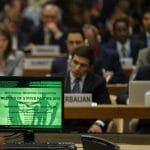Biosecurity lessons from the Bruce Ivins case
By Laura H. Kahn | August 8, 2008
We’ll never know if Bruce Ivins, a former U.S. government microbiologist, perpetrated the 2001 anthrax letter killings, but the circumstantial evidence is pretty convincing. The DNA of the anthrax strain used in the killings matched the anthrax strain in his laboratory. Searches of his home in Frederick, Maryland, turned up “hundreds” of letters similar to those used in the terrorist attacks. He couldn’t give investigators a good reason why he kept late-night hours at his lab, and, in other recent instances, he drove to mailboxes miles out of his way to mail letters with postmarks that wouldn’t be linked to his own. FBI investigators speculate that his motive was to get his anthrax vaccine produced for U.S. troops.
Ivins committed suicide on July 29 as federal prosecutors prepared to indict him on murder charges. His family and friends were stunned by the allegations; they knew him as a personable, religious family man.
The sad tale of Bruce Ivins illustrates that the most dangerous bioterrorism threat we face is from ourselves.”
Assuming that he really was the anthrax letter perpetrator and didn’t commit suicide because intense FBI surveillance drove his troubled mind further into intense paranoia, the Ivins case raises a troubling concern: Namely, massive U.S. biodefense spending and a buildup of high-containment laboratories throughout the country might have created an internal security risk that no outside terrorist group could ever duplicate. Nearly two dozen new federal and many more new private biosafety level 3 and 4 laboratories have been built in recent years, meaning a large cadre of scientists has access to extraordinarily lethal material.
The work in these laboratories is inherently dual-use. In a previous column, I wrote about some of the dangerous directions life sciences research has taken in the name of “biodefense.”
Even with extensive psychological screening and security background checks, people who breach the public’s trust occasionally get through the system, causing considerable harm. Former FBI Agent Robert Hanssen had sworn to enforce the law and protect national security, but he became a double agent for the Soviet Union for more than 20 years. In 2001, he was arrested at a park in Vienna, Virginia, after dropping off a box with highly classified information for his Russian contacts. He is now serving a life sentence without parole.
Similarly, it’s virtually impossible to identify scientists who might become psychologically unstable, or write a code of conduct capable of stopping them.
In light of these concerns, what direction should the United States take in its life sciences research agenda? In 2005, hundreds of U.S. microbiologists sent an open letter to Elias Zerhouni, the director of the National Institutes of Health, protesting the U.S. biodefense program’s excessive spending on hypothetical bioterrorist threats. They argued that the “biodefense” focus on exotic agents such as anthrax, plague, and tularemia should be scaled back and replaced with agents that actually jeopardize public health such as drug-resistant tuberculosis, West Nile virus, HIV/AIDS, and influenza. (See “Has Biodefense Gone Overboard?”)
Research on zoonotic diseases would address both bioterrorism and emerging infectious disease concerns. With the exception of smallpox, almost all of the bioterrorist threats are zoonotic agents, which are diseases of animals that infect humans. More than 70 percent of newly emerging infectious diseases such as HIV/AIDS, West Nile virus, SARS, and avian influenza come from animals. The government should invest in cross-disciplinary efforts between human and veterinary medicine to confront these real threats.
In addition, much of the money spent on biodefense should go to disease surveillance and control. A strong public health system is the best defense against any infectious disease outbreak. There’s been some progress in this area, but there’s still considerable room for improvement, demonstrated recently by the Salmonella outbreaks. (See “Ready or Not? Protecting the Public’s Health from Disease, Disasters, and Bioterrorism, 2007.”)
The sad tale of Bruce Ivins illustrates that the most dangerous bioterrorism threat we face is from ourselves. Now that the FBI has declared that the anthrax case is closed, there should be a congressional investigation into the entire saga that includes a public debate about our future priorities in “biodefense.”
Together, we make the world safer.
The Bulletin elevates expert voices above the noise. But as an independent nonprofit organization, our operations depend on the support of readers like you. Help us continue to deliver quality journalism that holds leaders accountable. Your support of our work at any level is important. In return, we promise our coverage will be understandable, influential, vigilant, solution-oriented, and fair-minded. Together we can make a difference.
Keywords: essential biosecurity reading
Topics: Biosecurity, Columnists















